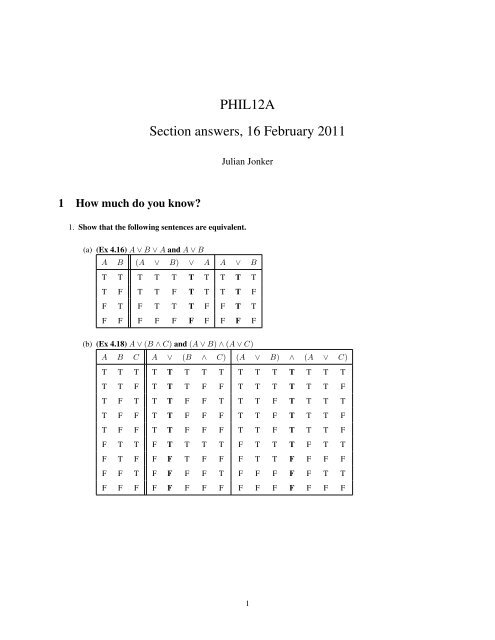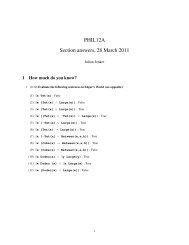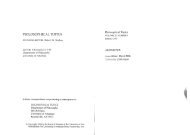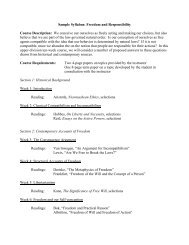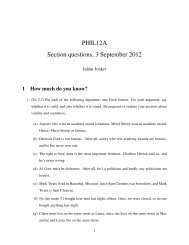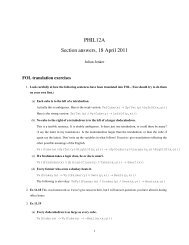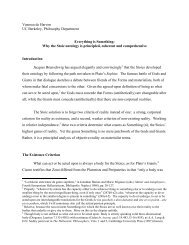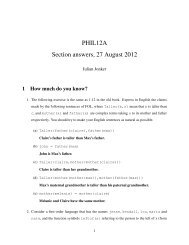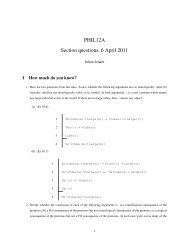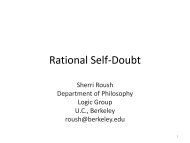PHIL12A Section answers, 16 February 2011 - Philosophy
PHIL12A Section answers, 16 February 2011 - Philosophy
PHIL12A Section answers, 16 February 2011 - Philosophy
You also want an ePaper? Increase the reach of your titles
YUMPU automatically turns print PDFs into web optimized ePapers that Google loves.
<strong>PHIL12A</strong><strong>Section</strong> <strong>answers</strong>, <strong>16</strong> <strong>February</strong> <strong>2011</strong>Julian Jonker1 How much do you know?1. Show that the following sentences are equivalent.(a) (Ex 4.<strong>16</strong>) A ∨ B ∨ A and A ∨ BA B (A ∨ B) ∨ A A ∨ BT T T T T T T T T TT F T T F T T T T FF T F T T T F F T TF F F F F F F F F F(b) (Ex 4.18) A ∨ (B ∧ C) and (A ∨ B) ∧ (A ∨ C)A B C A ∨ (B ∧ C) (A ∨ B) ∧ (A ∨ C)T T T T T T T T T T T T T T TT T F T T T F F T T T T T T FT F T T T F F T T T F T T T TT F F T T F F F T T F T T T FT F F T T F F F T T F T T T FF T T F T T T T F T T T F T TF T F F F T F F F T T F F F FF F T F F F F T F F F F F T TF F F F F F F F F F F F F F F1
2. For each of the following arguments, show that the conclusion is a tautological consequence of the premisesusing truth tables.(I’ll use the shortcut method in each case, starting by placing a T under the main connective of each premiseand an F under the main connective of the conclusion, and the working backwards until I hit a contradiction, atwhich point I will leave an x under the sentence to which I cannot assign a consistent truth value.(a) (Ex 4.20)1 (A ∧ B) ∨ C2 (B ∨ C)(A ∧ B) ∨ C B ∨ CTFT F F FT Fx T F F F F(b) (Ex 4.22)1 A2 B ∨ C3 ((B ∧ A) ∨ (C ∧ A)A B ∨ C ((B ∧ A) ∨ (C ∧ A)T T FT T F T F F TT Fx T Fx F F T F F F T2
(c)1 A ∨ B2 B ∨ C3 ¬B4 A ∧ CA ∨ B B ∨ C ¬ B A ∧ CT T T FT F F T T F FT T F F T T T F Tx F Tx(d) The following conclusion is in fact not a tautological consequence of the premises, as the truth assignmentbelow illustrates.1 A ∨ B2 C ∨ D3 ¬A ∨ ¬C4 B ∧ DA ∨ B C ∨ D ¬ A ∨ ¬ C B ∧ DF T T T T F T F T F T T F F3. Recall the following equivalences:Associativity of ∧: P ∧ (Q ∧ R) ⇔ (P ∧ Q) ∧ R ⇔ P ∧ Q ∧ RAssociativity of ∨: P ∨ (Q ∨ R) ⇔ (P ∨ Q) ∨ R ⇔ P ∨ Q ∨ RCommutativity of ∧: P ∧ Q ⇔ Q ∧ PCommutativity of ∨: P ∨ Q ⇔ Q ∨ PIdempotence of ∧: P ∧ P ⇔ PIdempotence of ∨: P ∨ P ⇔ PDouble negation: ¬¬P ⇔ P3
De Morgan’s laws: ¬(P ∨ Q) ⇔ ¬P ∧ Q)¬(P ∧ Q) ⇔ ¬P ∨ ¬QUsing these equivalences to put the following sentences into negation normal form, using a chain of equivalences.At each step of the chain, indicate which principle you are using:(a) (Ex 4.36) (¬A ∨ B) ∨ (B ∨ C)(¬A ∨ B) ∨ (B ∨ C) ⇔ ¬A ∨ B ∨ B ∨ C (Associativity of ∨)⇔ ¬A ∨ B ∨ C (Idempotence of ∨)(b) (A ∨ B) ∧ C ∧ (¬(¬B ∧ ¬A) ∨ B)(A ∨ B) ∧ C ∧ (¬(¬B ∧ ¬A) ∨ B) ⇔ (A ∨ B) ∧ C ∧ (¬¬B ∨ ¬¬A ∨ B) (De Morgan’s laws)⇔ (A ∨ B) ∧ C ∧ (B ∨ A ∨ B) (Double negation)⇔ (A ∨ B) ∧ C ∧ (A ∨ B) (Idempotency of ∨)⇔ (A ∨ B) ∧ C (Idempotency of ∧)(c) ¬(¬¬A ∧ ¬¬B) ∨ C ∨ (¬B ∨ ¬A) ∨ ¬A¬(¬¬A ∧ ¬¬B) ∨ C ∨ (¬B ∨ ¬A) ∨ ¬A ⇔ ¬(A ∧ B) ∨ C ∨ (¬B ∨ ¬A) ∨ ¬A (Double negation)⇔ (¬A ∨ ¬B) ∨ C ∨ (¬B ∨ ¬A) ∨ ¬A (De Morgan’s laws)⇔ (¬A ∨ ¬B) ∨ C ∨ (¬A ∨ ¬B) ∨ ¬A (Commutativity of ∨)⇔ (¬A ∨ ¬B) ∨ C ∨ ¬A (Commutativity of ∨)⇔ ¬A ∨ ¬B ∨ C ∨ ¬A (Associativity of ∨)⇔ ¬A ∨ ¬B ∨ C (Idempotency of ∨)2 Something slightly harder, if there’s time.1. Think of two sentences P and Q such that P is a logical consequence of Q, but not a tautological consequence.An example: P: ‘x = 2’, Q: ‘x 2 = 4’4
2. (Ex 4.25) Is A ∧ B a tautological consequence of A ∨ B? Give an example of two different sentences Aand B in the blocks language such that A ∧ B is a logical consequence of A ∨ B.A ∧ B is not a tautological consequence of A ∨ B: consider for example the row of the truth table in which Ais true and B is false.However, if A is interpreted as LeftOf(a,b) and B is interpreted as RightOf(b,a), then we have thatA ∧ B is a logical consequence of A ∨ B.3. When using truth tables to determine whether one sentence is a tautological consequence of a set ofsentences, you normally write out all possible truth values for each atomic sentence. Once you have morethan three atomic sentences, this becomes laborious. Is there a quicker way to do it? Show how to do itwith one of the examples above.See the examples above!3 Challenge questionConsider the arbitrary sentence φ consisting of parentheses, ∧ symbols, ∨ symbols, ¬ symbols and n atomicsentences. (Make up an example of such a complex sentence and draw its truth table in order to help with thequestions that follow.) What are the reference rows of its truth table? How many rows in its truth table? Can atruth value be assigned to each row of the truth table of φ? How would you justify this?Consider for example φ = ¬(¬(A ∨ B) ∧ C). The truth table for this sentence has three reference columns andeight rows. Since the sentence consists of just atomic sentences, parentheses and truth-functional connectives, we candraw up a truth table and assign a truth value in each row on the basis of the truth values of the atomic sentences andthe definitions of the truth-functional connectives.Now imagine that you have such a truth table. Consider the rows which make φ true. For each such row,there is a way to compose a sentence L i using the atomic sentences in φ, ∧ symbols and ¬ symbols. Can youwork out how to do it? (Think about what this row of the truth table means, and how you could express thismeaning using just the atomic sentences of φ, ∧ symbols and ¬ symbols.)Here is the truth table for φ:5
A B C ¬ (¬ (A ∨ B) ∧ C)T T T T F T T T F TT T F T F T T T F FT F T T F T T F F TT F F T F T T F F FF T T T F F T T F TF T F T F F T T F FF F T F T F F F T TF F F T T F F F F FEach row of the truth table produces a truth value under the main connective of the sentence that is a function ofthe truth values of the atomic sentences. A truth table is just an intuitive way of illustrating this. However, we couldtalk about the function F ¬(¬(A∨B)∧C) as a function from all the possible combinations of truth values of the atomicsentences to the two truth values T and F. So each row represents the value that this function takes on when giventhe truth values under the atomic sentences as its arguments. In other words, we could represent the second row ofthe truth table in the following way: F ¬(¬(A∨B)∧C) (T, T, F) = T. For each arbitrary sentence we could produce afunction in the same way mapping the combinations of the atomic sentences to T and F.Now consider that for each row there are a finite number of true atomic sentences upon which the truth valueof the sentence depends. If the sentence is true in this row, then its truth value is equivalent to the conjunction ofthose atomic sentences which are true and the negations of those atomic sentences which are false. For example,F ¬(¬(A∨B)∧C) (T, T, F) = T = F A∧B∧¬C (T, T, F). So we let L 2 = A ∧ B ∧ ¬C. Similarly, for each row in whichφ is true, there is a sentence L i consisting of the conjunction of the atomic sentences that are true in that row and thenegations of those atomic sentences which are false. If any such sentence L i is true, it is because the atomic sentencesof which it consists take on the truth values that match the ith row of the truth table, and by construction φ is true inthat row. So whenever any L i is true, φ is also true.Now convince yourself that φ is equivalent to the disjunction of the Ls – that is, L 1 ∨ L 2 ∨ ...L j , where j isthe number of true rows of the truth table. If you have got this far, well done. You have demonstrated why it isthat every sentence we can so far, no matter how complex the sentence, can be written in negation normal form.(Actually, you have shown something more: that every sentence can be written in disjunctive normal form.)Suppose there are j true rows of the truth table of φ. Since φ is true when L 1 is true, or when L 2 is true, ... ,or when L j is true, it follows that φ is true when at least one of the disjuncts of L 1 ∨ L 2 ∨ ... ∨ L j is true. Also,since the truth table of φ exhausts the possible combinations of truth values of the atomic sentences of φ, we knowthat when φ is true it is true in some ith row of its truth table. But in that case L i is true, and so the disjunctionL 1 ∨ L 2 ∨ ... ∨ L j is true. This means that φ is equivalent to L 1 ∨ L 2 ∨ ... ∨ L j , a sentence in disjunctive normal form.Since φ was arbitrary, we conclude that we can represent any sentence consisting of atomic sentences, parentheses andtruth-functional connectives in disjunctive normal form.6


